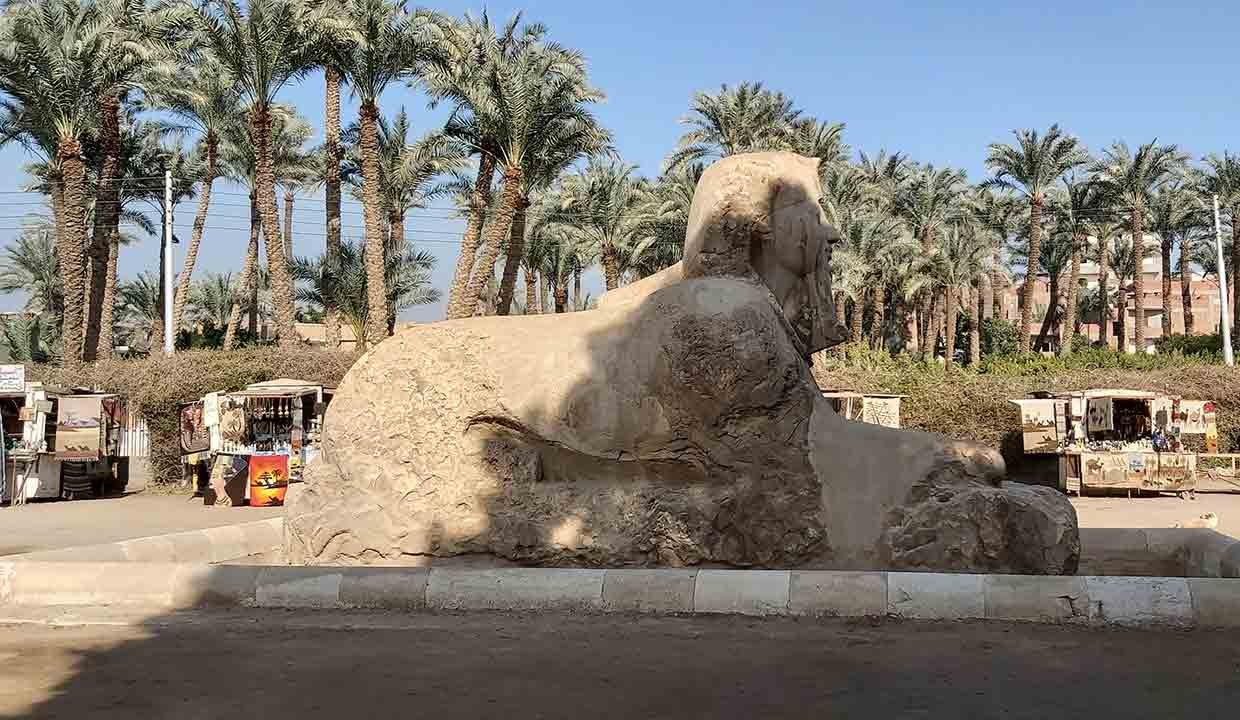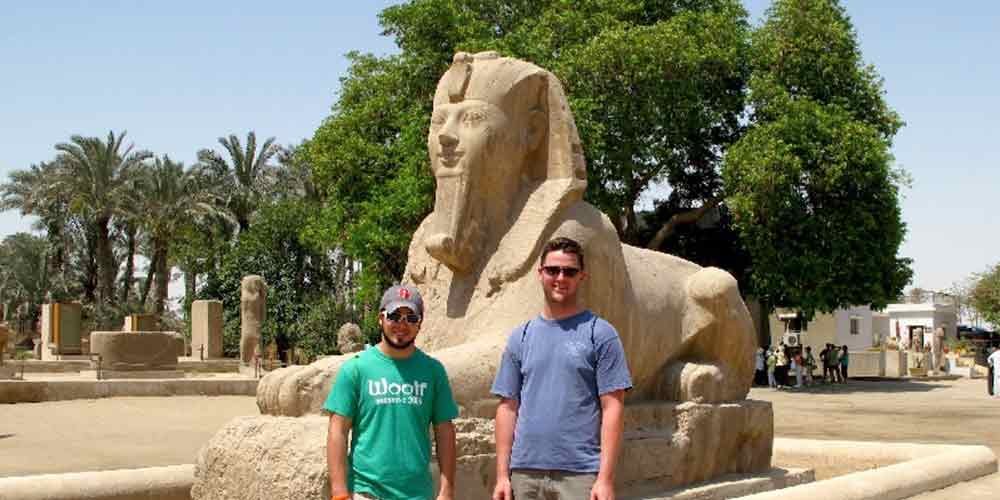Wonderful Memphis
Memphis
Memphis, situated on the west bank of the Nile, 23 kilometers (14 miles) south of Cairo, close to the Saqqara necropolis was the administrative capital of Egypt during the Old Kingdom, part of the Middle and New Kingdoms, during the Late Period, and then again in the Ptolemaic period. During the Roman period, the importance of Memphis in the spheres of commerce and administration began to decline as the Romans favored the fortress town of Babylon, the location of present-day Cairo. Babylon afforded the Romans better control of their trade networks. After the Arab conquest of Egypt in 641 AD, the garrison city of Fustat (also part of present-day Cairo), incorporated Babylon and became the first Muslim capital of Egypt, and ultimately, the Cairo we have today. With religious, commercial, and administrative centers firmly established in the Cairo area, the once-thriving metropolis of Memphis ultimately, disappeared below the village of Mit-Rahina and surrounding farmland.
According to the Greek historian Herodotus, Memphis was founded by Menes, the legendary unifier of Egypt and its first Dynastic ruler (c. 3100 BC). The name Memphis possibly derives from the Pyramid and mortuary temple of Pepy I at Saqqara called Men-nefer meaning ‘fixed and beautiful’. Hence, Memphis in Greek and Manf in Arabic. Other names for the city used during Pharaonic times were indw-hedj, ‘White Walls’ or ‘White Fortress’, and ‘Hwt-ka-Ptah’, meaning, ‘Temple for Ka of Ptah’, or, ‘House of the Ka of Ptah’. This name is the most enduring legacy of Memphis because the Greeks pronounced ‘Hwt-ka-Ptah’ as Aegyptus (Aigyptos), which later became Egypt.

Old Kingdom (c. 2686 – 2160 BC)
In-situ remains of the Old Kingdom Memphis have to date not been found or excavated. However, the period is tantalizingly present in the form of pottery sherds and stone sculptures. On the north side of the First Intermediate Period cemetery at Kom el-Fakhry, Barry Kemp in March 1976 observed Old Kingdom pottery sherds (Kemp 1976). The sherds were observed in debris rising up to 1 m above the walls of the tombs, and most likely represent inclusions in the material of a much later date.
First Intermediate Period (c. 2160 – 2055 BC)
The mudbrick vaulted and stone-lined tombs at Kom el-Fakhry are at present the earliest excavated remains at Memphis. The tombs were found in 1951 during the construction of the Saqqara to Bedrashein Road.
Middle Kingdom (c. 2055 – 1650 BC)
The earliest settlement remains that have been excavated to date are at Kom el-Fakhry and Kom el-Rabia. The remains at Kom el-Fakhry are situated on the eastern side of the First Intermediate Period cemetery and were also discovered during the construction of the Saqqara to Bedrashein Road in 1951. The settlement was excavated by Mohammed Ashery of the Antiquities service in 1981. Ashery revealed at least two Middle Kingdom phases to the settlement which comprised large rooms organized either side of an east-west street that gave access to the eastern frontage of the cemetery.

New Kingdom (c. 1550 – 1069 BC)
As mentioned earlier, the most evident remains at Memphis relate to the New Kingdom, especially the nineteenth dynasty and the reign of Ramesses II.
The Eighteenth Dynasty
The majority of the eighteenth dynasty is represented in the form of 40 complete stone tablets and 150 fragments of tablets found by Petrie beneath the foundation sand of the Ptah Temple West Gate built by Ramesses II.
The eighteenth dynasty could also be represented in magnificent style at Memphis in the form of the greatest Pharaonic sculpture from a single block of calcite in all Egypt. I am talking about the Sphinx on display at the Memphis Open Air Museum. It was found by Petrie (1911 – 1912) close to its current location inside the great Ramesside temple to Ptah, suggesting that it may have been part of a monument within the temple enclosure.
The Nineteenth Dynasty
The nineteenth dynasty is the most visibly represented period at Memphis, especially in the southern part of the site. Although Ramesses II built a large new city in the Delta at Piramesse, he carried out an extensive building program at Memphis. The following is a list of the nineteenth dynasty remains:
Chapel of Sety I: This is the earliest of the monuments and is situated within the Great Ptah Temple, on the southern side of the Saqqara to Bedrashein Road. It was discovered during drain cutting works and excavated by Labib Habachi in 1950. Inside the chapel is a seated statue of the god Ptah flanked on either side by the goddess Tjesemet and Mn-nfr, both also seated with a young Sety I on their laps.
Ramesses II Chapel: This relatively small monument is situated immediately west of RAD and on the southern side of the Great Ptah Temple at its southwest corner. It was built by Ramesses II and dedicated to the god Ptah. The temple was excavated by Ahmed Badawi in 1942 and again by the University of Pennsylvania in 1955 and 1956.
The Temple of Hathor: This temple was built by Ramesses II and dedicated to the god Hathor, although the god Ptah is also represented. It is situated south of the Saqqara to Bedrashein Road and southwest of the Memphis Open Air Museum. It was discovered by the Egyptian army in 1969 and the courtyard was excavated by Abdulla Sayed Mahmoud in 1970.
Temple of Sekhmet: This temple was again built by Ramesses II and was apparently dedicated to the god Ptah and goddess Sekhmet. It is only thought to be dedicated to these gods after a triad statue of Ptah flanked on either side by Ramesses II and Sekhmet was found at the back of the temple in the central chapel. This statue is on display at the Memphis Open Air Museum. The temple is situated off the southern side of the Memphis Museum and flanks the southern approach to the Great Ptah Temple. It was found in 1956 and excavated by Mohamed Abd el-Twab el-Hitta in 1962.
The Ptah Temple West Gate: Only the west gate of this enormous temple to the god Ptah is now visible. This temple originally measured 462m east-west by 632m north-south with a large gate at the cardinal points. The temple was built by Ramesses II and the colossal limestone statue of the king in the Memphis Open Air Museum. most likely flanked the southern gate, and the red granite colossal statue also of Ramesses II that stood outside the railway station in Cairo, now at the site of the Grand Egyptian Museum (GEM), flanked the east gate. Two further colossal statues of the king in red granite on display in the Memphis Open Air Museum may have also flanked the south gate of the Great Ptah Temple. A small stela from the reign of the twenty-sixth dynasty king Apries found in the vicinity of the Great Ptah Temple has a depiction of how the south gate of the temple may have looked.
The pharaohs did the impossible. Explore their mysterious ancient city, the first capital of Egypt, Memphis … with Explore Egypt Tours Team.

Explore Egypt Tours Tripadvisor



Comment (0)